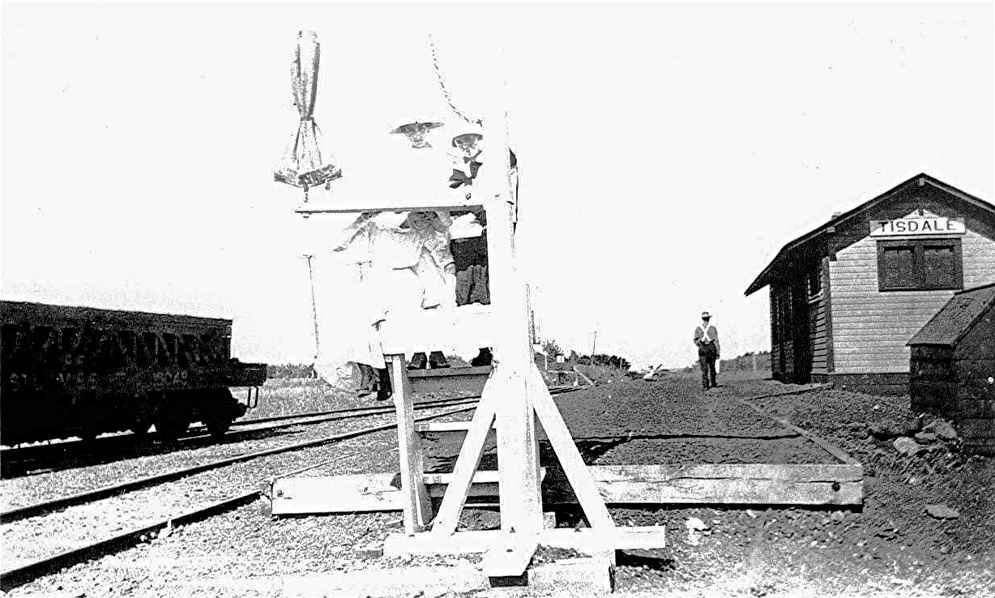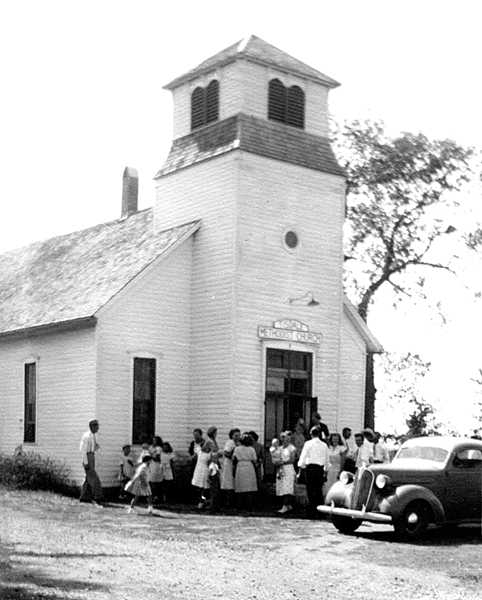|
Luetta Scott – Mother of Warren Scott
|
| This valuable history was sent to Mrs.
Ivan J. Scott for the 1970 observance of Tisdale Church 85th
Anniversary was written while Rev. Beason was a student in Southwestern
College and he wrote me that I may keep it. (Warren Scott’s Mother) |
|
(from a note attached to the book) Laying of
the Corner Stone March 26, 1948. The metal box contains roll of
membership, A white Bible, King James Version, The Methodist Discipline, A Winfield Courier, List of names of children baptized, A history of the Tisdale Church. |
|
The first Trustees were Mr. Try – Mr.
Hugh Chance and Mr. Moffet For full-time pastor Later Charley Cavit – Mr. Philip Cook –
Ivan Scott Pledged to raise salary for full time
pastor – not a circuit, Increased interest and membership. |
|
Rev. Steadman Aldis was a preacher
here, then went to India to tell the people there of Jesus – "Go into all the
World". An acre of land was purchased November
10, 1884. Building of first part completed in June
1885. The second part build in 1923-4 while
Reverend Archie B. Madison was pastor.
|
- Why did my church begin? Because people in this
new country had a love of God and wanted a place to worship together.
- Where did my church begin? First meetings/services
were held in home of Mr. and Mrs. Ellinger – by a man named Elder
Thomas. Then when school house was built (1872) service was held in that
till Tisdale Church was built. A circuit – let by father Knight. Burden
Rev. Long – Rev. McKibben – church records were lost or destroyed some
way.
|
|
Rev. Stewards preached in school
house promoted building a church. Mr. Ellinger build the
foundation and chimney, people of many denominations attended and
helped, later more Methodists and it was dedicated as Methodist. |
| |
|
History of Tisdale to 1927 |
|
Mace V. Beason |
|
The Kansas Emigrants. By Whittier |
| |
|
|
| |
We cross the prairie as of old |
|
| |
The pilgrims crossed the sea. |
|
| |
To make the West, as they the East, |
|
| |
The homestead of the free. |
|
| |
We go to rear a wall of mess |
|
| |
On Freedom’s southern line.
|
|
| |
And plant beside the cotton-tree
|
|
| |
The rugged northern pine!
|
|
| |
We’re flowing from our native hills
|
|
| |
As our free rivers flow: |
|
| |
The blessing of our motherland
|
|
| |
Is on us as we go. |
|
| |
We go to plant her common schools
|
|
| |
On distant prairie swells.
|
|
| |
And give the Sabbaths of the wild |
|
| |
| The music of her bells. |
| Upbearing, like the Ark of old,
|
| The Bible in our van. |
|
We go to test the truth of God
|
|
Against the fraud of man.
|
|
No pause, nor rest, save where the
streams
|
|
That freed the Kansas run. |
|
Save where our Pilgrim goufalou
|
|
Shall floaut the setting sun.
|
| We’ll tread the prairie as of old |
| Our fathers sailed the sea. |
| And make the west as they the East, |
| The homestead of the free! (1984) |
| |
|
|
|
|
History of Tisdale. |
|
No make believe pioneers were those
sturdy hearted, sun-tanned sons and daughters of the plainsmen and
mountaineers, who followed the Forty-niners westward some years later. |
|
Those trail-blazers came in true
pioneer fashion, with ox-teams and prairie schooners, not in search of
gold, but rather they came seeking to establish homes and to prepare the
way for civilization. |
|
Slowly westward, but steadily
westward, moved the caravans of lumbering ox-teams and prairie
schooners, on and on into the far-flung untamed country of the west,
they bore their precious cargos of hardy pioneers. |
|
Only virgin soil and unbounded
treeless, rolling plains stretched into tiresome distances in very
direction. The only inhabitants of these unconquered western expanses
before the coming of the white man’s onward march, were the savage,
war like Indians and their companions of the prairies, the buffalo, the
antelope, the jack-rabbit, the wiley coyote and the rattlesnake. |
|
The untamed plains and prairies
began at length to yield to the relentless, indemonstrable spirit and
will of the invading pioneers. Early in the sixties those who
wandered southward from the Santa Fe Trail might have found, in the
Walnut Valley in that portion of the state which later came to be known
as Cowley County, the small beginnings of a little village. And there
were those who did come southward and who found this little daughter of
the prairie. This village later developed into Winfield, the county seat
of Cowley County. |
|
Before the United States survey had
been made of the territory now known as Cowley County, a town company
was formed by settlers then living at Emporia. These men came and
establishing a town at the junction of the Walnut and Arkansas rivers,
which they hoped to make the county seat of the county soon to be
surveyed. The junction of the two rivers was chosen as the town site in
the belief that it was the central point of the county. |
|
The town started there was first
called Creswell for one of the state officials of that time. But when a
Post Office was applied for, it was learned that a Kansas town of that
name was already in existence. Delphi was then decided upon as the
proper name, but when the Post Office was granted it was named Arkansas
City, which name it has since borne. |
|
The two newly established villages
of the frontier, Winfield and Arkansas City, at once became rivals in
their quest for the County Seat. |
|
In an election help on May 2, 1870
Winfield, although considerably smaller than Arkansas City, was declared
the County Seat by a vote of 108 to 55. This election, however, did not
settle the contest between the rival towns. |
|
"On July 15, 18780 Congress passed
a law to open up the Osage Diminished Reserve to settlement. The law was
first to be ratified by the Osage Chiefs and then the land was to be
surveyed by the government and sold to actual settlers in quantities not
exceeding 160 acres, to each ‘in square firm’." The passage of this law
attracted large numbers of settlers to Cowley County. |
|
The search for suitable homestead
lands drew prospective settlers five, six, seven, eight and even nine
miles east of Winfield, to what has since come to be known as the
Tisdale Community. The first homesteader of the community was a man
named Foughty, a veteran of the Civil War, who had lost a limb in that
conflict. He homesteaded the land now owned by Elijah Bailey. His log
cabin built of threes hewn on Silver Creed, stood back in the field on
the north side of the road, a few rods north of the large stone house
now owned by Billy Bailey. |
|
The county survey was made in
January 1871, by the United States Deputy Surveys, O. F. Short and
Angell. The survey caused a great deal of excitement among the settlers
and prospective settlers of the county. Men driving ox teams, to wagons
loaded with lumber followed the surveyors and as soon as a quarter
section of land was surveyed which had no buildings on it, the first man
there with his lumber unloaded and began to build, in order to hold the
land until he could homestead it.
The county lines were now
established by the government surveyors, and Arkansas City was found to
be 4 ˝ miles from the south line and 6 miles from the west line, instead
of being locted in the center of the county. While Winfield was 8 ˝
miles due west of the center.
It then became evident to Arkansas
City that it was useless to compete longer for the County Seat; but it
was thought that a new town might be started which might take the County
Seat from Winfield. Therefore the founders of Arkansas City formed a
town company with a charter bearing the date June 13, 1871. The company
was composed of D. A. Keith, president and C. R. Mitchell, Secretary. It
was given the name "The Tisdale Town Company." It proceeded to lay claim
to the land about the geographical center of the county and to erect
building and establish a town called Tisdale.
The Winfield Town Association which
had been looking for some such move, arrived at the geographical center
with lumber and claimants nearly as soon as the new town company, and
jumped their rivals’ claims. "But the Winfieldites did not win this
time." The founders and claimants of the new town could steal more
lumber during the night than their rivals could haul out during the day.
And finally Winfield abandoned the task, deciding it to be too
expensive, and left the ground to their rivals who proceeded to lay out
the town side and to complete the building already begun, and to erect
others. The town site was then just east of the present location of the
Tisdale Community M. E. Church. In fact the town well still exists. It
is located in the very center of the Tisdale road about in front of the
driveway leading to Mrs. Bevins’ house. A large slab of stone covers the
mouth of the well and the road is graded over it.
The Tisdale Township was organized
August 1, 1871, with S. S. Moore, Township Trustee. J. A. McGuire, Clerk
and G. W. Foughty, Treasurer.
The building enterprises at Tisdale
had progressed rapidly and then even in so short a time it was a
thriving pioneer town. It consisted of a number of dwelling houses and a
business section of no little consequence for such a primitive country
in so early a time. The business section was then composed of two
general stores, each carrying a complete stock of drygoods and
groceries, some hardware, harness and implements. The proprietors of
these two establishments were J.A. McGuire, and M. G. Trupp. In addition
to these two general stores the business block of the town could boast
of a printing office, the birthplace and fist home of "The Cowley County
Telegram" (a year later), a drug store, a post office, a blacksmith
shop, and a hotel. The hotel still stands and is in good condition. For
years it has been the commodious dwelling fo farmer-fold. The Tisdale
Hotel is the large stone house standing on the corner west of the
church, now owned and occupied by Billy Bailey and his family.
The hotel was indeed a splendid
piede of workmanship, a building of which an early County-seat town
could well feel proud. Similar structures were seldom seen in this
section of the country at that time.
Petitions were circulated for an
election with the intention of relocating the county seat.
|
| |



